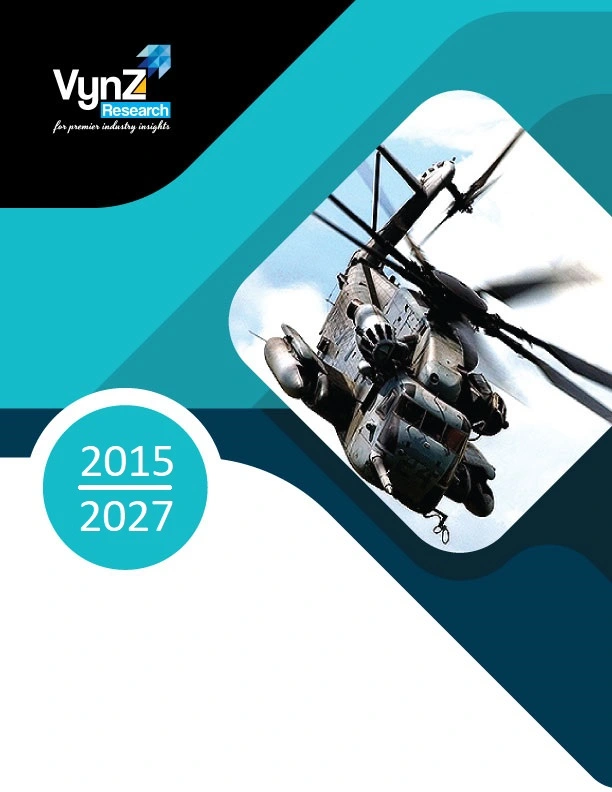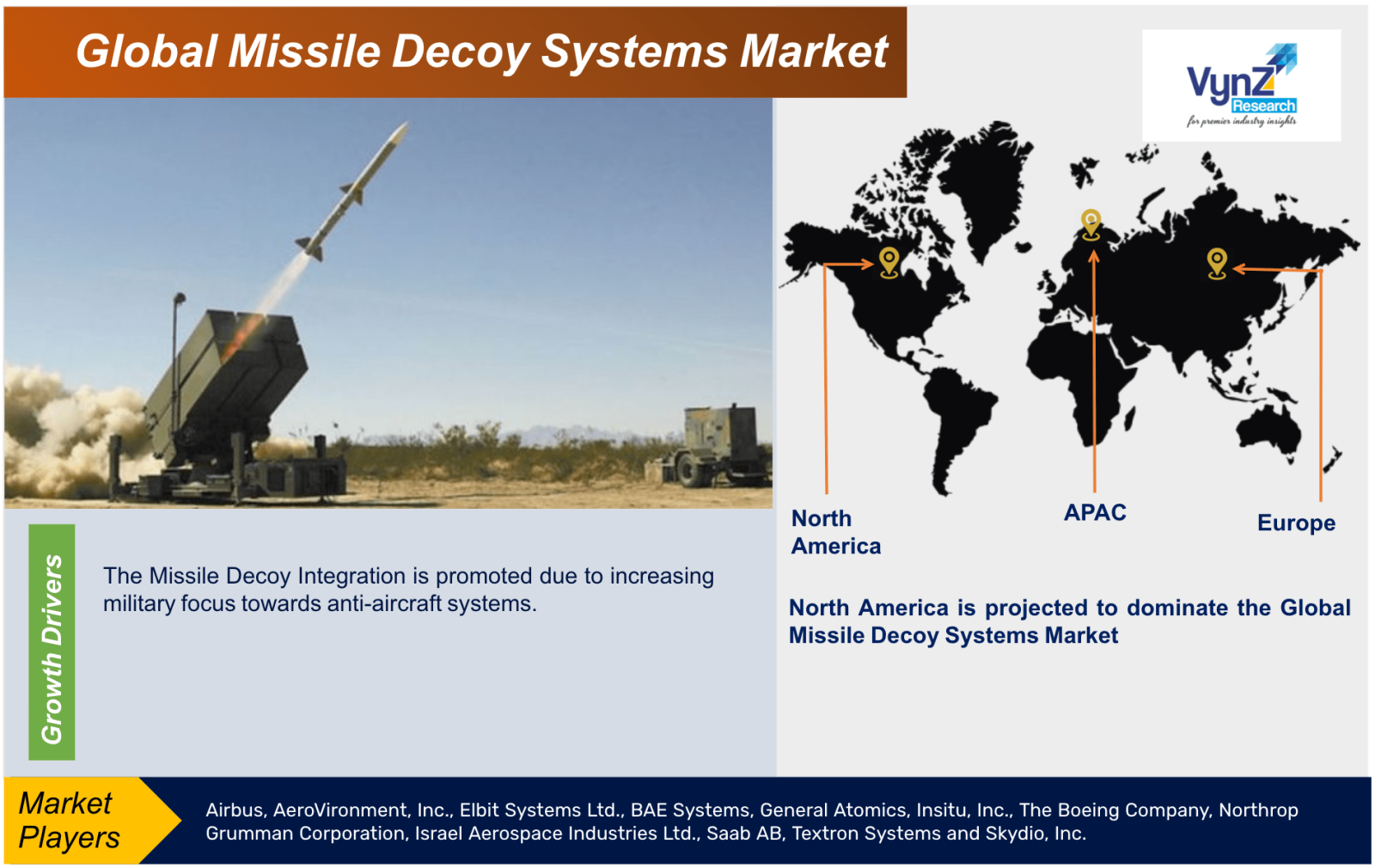| Status : Published | Published On : Jul, 2024 | Report Code : VRAD12033 | Industry : Aerospace and Defense | Available Format :

|
Page : 205 |

Global Missile Decoy Systems Market - Analysis and Forecast (2025-2030)
Industry Insights By Function (Infrared Decoy Systems, Radar Decoy Systems, Laser Decoy Systems, Electronic Warfare Decoy Systems, Other Decoy Systems (Acoustic, Visual, etc.)), By Platform (Airborne Decoy Systems, Naval Decoy Systems and Ground-based Decoy Systems) and By Geography (North America, Europe, Asia-Pacific, South America and Middle East and Africa)
Industry Overview
The Global Missile Decoy Systems Market is anticipated to grow at a CAGR of 19.58% during the forecast period from 2025 to 2030.

Missile Decoys are the airborne projectiles used to counter enemy missiles to safeguard military assets like Inter Continental Ballistic Missiles, ships, aircraft etc. The missile decoys replicate electronic and infrared signatures to mislead the enemy missiles and effectively deviate their proposed path to secure airborne, sea-borne, and land-based platforms.
Additionally, the need for advanced countermeasures is increasing due to the growing importance of precision-guided missiles and their ability to target critical infrastructure and military assets. Hence, to secure the airborne systems, various militaries around the globe have planned to integrate missile decoy systems to secure their assets in hostile environments.
Market Segmentation
Insight by Function
On the basis of Function, the global Missile Decoy Systems market is segregated into Infrared Decoy Systems, Radar Decoy Systems, Laser Decoy Systems, Electronic Warfare Decoy Systems, Other Decoy Systems (Acoustic, Visual, etc.). Radar Decoy Systems segment shall dominate the global Missile Decoy Systems Market. With the growing advancements of radars, the usage of multiple radio frequencies for effectively engaging enemy aircraft has extensively grown. A large number of aerial threats are equipped with radar-based sensors for targeting & detection, as radar offers a long stand-off range to the strike missiles.
Insight by Platform Type
Based on platform, the global Missile Decoy Systems Market is segregated into Airborne Decoy Systems, Naval Decoy Systems and Ground-based Decoy Systems. Airborne platform shall dominate the Global Missile Decoy Systems Market during the forecast period. Improved survivability is at the center of focus with the emergence of 4.5 and 5th-generation aircraft. A large number of aircraft such as Eurofighter Typhoon, F35, Rafael, etc. use active missile decoys to ensure survivability in the increased threat scenarios. The demand for advanced military fighter jets and other equipment is rising substantially, as airborne threats, such as enemy aircraft, drones, and cruise missiles, can easily approach targets from long distances. This is anticipated to further boost the demand for enhanced missile decoy systems from airborne platforms across the world.
Global Missile Decoy Systems Market Report Coverage
|
Report Metric |
Details |
|
Historical Period |
2018 - 2023 |
|
Base Year Considered |
2024 |
|
Forecast Period |
2025 - 2030 |
|
Market Size in 2024 |
U.S.D. xx Billion |
|
Revenue Forecast in 2030 |
U.S.D. xx Billion |
|
Growth Rate |
19.58% |
|
Segments Covered in the Report |
By Function, By Platform |
|
Report Scope |
Market Trends, Drivers, and Restraints; Revenue Estimation and Forecast; Segmentation Analysis; Impact of COVID-19; Companies’ Strategic Developments; Market Share Analysis of Key Players; Company Profiling |
|
Regions Covered in the Report |
North America, Europe, Asia-Pacific, South America and Middle East and Africa) |
Industry Dynamics
Growth Drivers
The Missile Decoy Integration is promoted due to increasing military focus towards anti-aircraft systems. Various countermeasures have also been devised by the countries which include effective, quick response and highly mobile surface-to-air missiles with the advancement of aircraft technology towards modern electronic warfare systems, radar absorbent materials, avionics, supercruise, etc. Various countries have focused on installing active missile decoys on board to deceive enemy missiles through the simulation of heat, radar and electronic signatures of the aircrafts as militaries require operations in diverse threat environment securing a high-value, fighter jet which has become a priority. Furthermore, the demand for installing missile decoys to cope with the new age anti-aircraft missiles has extensively grown with the large number of 4th generation and 5th generation aircraft at the disposal of air forces around the world. Therefore, integrating missile decoys has become a cost-effective solution for operating aircraft, as upgrading and advancing onboard systems demand substantial investments to create a strong electronic warfare system. Further, the advantages of cruise missile decoys such as versatility, cost-effectiveness and adaptability are some of the aspects that shall propel their adoption among global economies for enhanced security in the upcoming years.
Restraints
Because of geopolitics & cost constraints, increasing international sanctions shall hinder the market growth of missile decoy systems. Long-range missile capabilities have become more accessible to both state and non-state actors with the evolving landscape of modern warfare, posing a significant threat to military assets and civilian populations. Limitations on the supply of defense equipment around the globe due to the imposition of trade sanctions in Russia, Ukraine, etc., have widely restricted access to advanced technologies and components, thereby hindering the development and procurement of sophisticated defense systems like missile decoys. Furthermore, due to sanctions countries that are under financial crunch, opt for more cost-effective defense solutions of advanced technologies such as missile decoy systems. Hence, the restricted access to technology and limited financial resources hamper the demand for missile decoy systems across the world.
Geographic Overview
- North America
- Europe
- Asia Pacific (APAC)
- South America
- Middle East and Africa
North America is projected to dominate the Global Missile Decoy Systems Market, with the surging deployment of military hardware and investment to integrate missile decoys to safeguard their military assets. Missile decoy manufacturers such as Raytheon, BAE Systems, and Leonardo, are working in coordination with North American economies to integrate advanced missile decoy systems in their naval, air and land military systems in the recent years.
Competitive Insights
With strategic initiatives, such as collaborations, mergers and acquisitions, the leading market players are looking forward to strengthening their market position.
Airbus SE is a European multinational aerospace corporation. The company’s primary business is the design and manufacturing of commercial aircraft but it also has separate defence and space and helicopter divisions.
AeroVironment, Inc. is an American defense contractor headquartered in Arlington, Virginia, that designs and manufactures unmanned aerial vehicles.
Key Players Covered in the Report
The key players of Global Missile Decoy Systems Market are Airbus, AeroVironment, Inc., Elbit Systems Ltd., BAE Systems, General Atomics, Insitu, Inc., The Boeing Company, Northrop Grumman Corporation, Israel Aerospace Industries Ltd., Saab AB, Textron Systems and Skydio, Inc.
Recent developments by Key Players
The U.S. Department of State approved a possible foreign military sale of AeroVironment's (AV) Switchblade 300 loitering munition systems to Taiwan, estimated at USD 60.2 million. The sale is intended to enhance Taiwan’s defensive capabilities and support U.S. national security and economic interests in the Indo-Pacific region. The Switchblade 300 systems are designed to provide real-time intelligence, surveillance, reconnaissance (ISR) and precision strike capabilities.
The US Navy has selected BAE Systems to develop a Dual Band Decoy (DBD), an advanced countermeasures pod to help protect the Boeing F/A-18E/F Super Hornet.
The Global Missile Decoy Systems Market report offers a comprehensive market segmentation analysis along with the estimation for the forecast period 2025–2030.
Segments Covered in the Report
- By Function
- Infrared Decoy Systems
- Radar Decoy Systems
- Laser Decoy Systems
- Electronic Warfare Decoy Systems
- Other Decoy Systems
- Acoustic
- Visual
- By Platform
- Airborne Decoy Systems
- Naval Decoy Systems
- Ground-based Decoy Systems
Region Covered in the Report
- North America
- U.S.
- Canada
- Mexico
- Europe
- Germany
- U.K.
- France
- Asia-Pacific (APAC)
- China
- Japan
- South Korea
- India
- South America
- Brazil
- Argentina
- Rest of South America
- Middle East and Africa
- Turkey
- UAE
- Saudi Arabia
- South Africa
- Rest of MEA
.png)
Source: VynZ Research
.png)
Source: VynZ Research
Frequently Asked Questions
Purchase Options
Latest Report
Research Methodology
- Desk Research / Pilot Interviews
- Build Market Size Model
- Research and Analysis
- Final Deliverabvle
Connect With Our Sales Team
- Toll-Free: 1 888 253 3960
- Phone: +91 9960 288 381
- Email: enquiry@vynzresearch.com
Missile Decoy Systems Market
